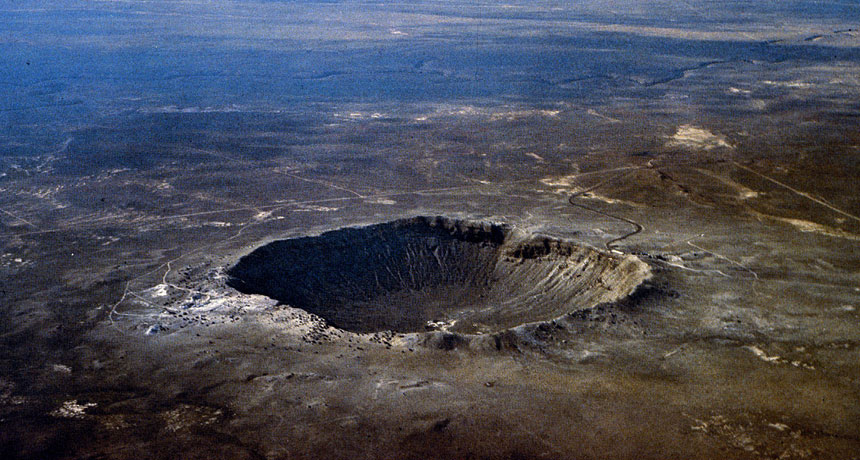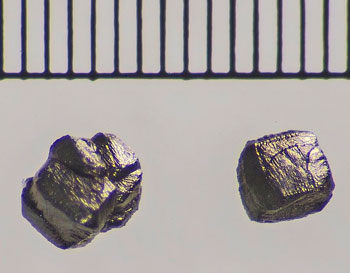Smash hit: Making ‘diamond’ that’s harder than diamonds
Scientists capture the creation of an elusive cousin of the diamond

The Canyon Diablo meteor was travelling faster than 10 kilometers per second (22,000 miles per hour) when it smashed into Earth 50,000 years ago. Scientists first discovered lonsdaleite at the impact site — Barringer Crater in Arizona.
D. Roddy
By Beth Geiger
Scientists suspected that if a meteorite smashed into Earth hard enough, it could change a type of soft, pure carbon — the graphite in pencil lead — into a mineral harder than diamond. Now, scientists say they have confirmed that can happen. They witnessed it from front-row seats.
No, they didn’t have to dodge an incoming space rock. Standing in for the meteorite was a high-energy laser. As its beam slammed into graphite, it created pressures close to two million times the normal atmospheric pressure on Earth’s surface.
Dominik Kraus is a physicist at the University of California, Berkeley. He and his colleagues used a laser at the Stanford National Accelerator Laboratory in California.
This isn’t the first that that scientists have subjected graphite to such great pressures with a high-energy laser. But this time, physicists made a “movie” of what happened. They used the world’s brightest, fastest X-ray. It’s known as the Linac Coherent Light Source.
And the results were crystal clear.
At a pressure of about 0.5 megabars — or 500,000 times atmospheric pressure — graphite morphed into diamond. But when the laser unleashed extremely fast but violent shocks — ones that more than tripled the pressure needed to make diamonds — a new mineral emerged. It became a special type of diamond known as lonsdaleite.
And the X-ray captured it all in a series of super-fast images. Played together, the images offer a close-up movie of the transformation.
In a billionth of a second
Those movies showed a wave of change as graphite morphed into diamond or lonsdaleite. And the change happened breathtakingly fast — in less than a nanosecond. That’s one billionth of a second!
The team published its results March 14 in Nature Communications.
How can one mineral become another? Both graphite and diamond are made of carbon atoms bound to each other. In the soft, gray graphite, those carbon atoms are in sheets. In hard, clear diamond (which forms under extreme pressures) the atoms are arranged in repeating cubes. Graphite and diamond are a little like bread and crackers. They have the same ingredients but in different form.
Graphite is common in our planet’s crust. Diamonds usually form at least 160 kilometers (100 miles) below Earth’s surface. Volcanic activity carries them upward. But geologists also have found microscopic diamonds in and around the craters formed by meteorite impacts. The intense pressure of those impacts turned graphite into its hard, famous cousin.
Geologists had suspected that londsaleite would be the next step up. They thought it would be an even harder type of carbon. But they’d only ever found impure, badly damaged bits of it. No one was sure what it would take to make the mineral. And they didn’t know whether it could be forged directly from graphite.
“This research confirms that impact cratering can transform graphite in the Earth’s crust to lonsdaleite,” says David Kring. He’s a planetary geologist with the Lunar and Planetary institute in Houston, Texas. Kring studies meteorites but was not involved in this study.
The new tests show that londsaleite can be used as telltale evidence of unusually violent blasts from the past, the researchers say.
Diamonds — or something new?
“Almost all impacts will produce diamond if there is enough carbon around,” says Dirk Gericke. This physicist at the University of Warwick in Coventry, England, is a co-author of the new study. But to produce lonsdaleite, he explains, a faster, more powerful impact is needed. Kraus estimates that a meteorite would have to smash into Earth at speeds of at least 10 kilometers per second (22,000 miles per hour) to transform graphite into lonsdaleite.

Whether lonsdaleite is something new or just some unusual type of diamond, this substance could be useful. It may a good marker for unusually violent meteorite impacts. And because this mineral is harder than diamond, it would make a great material for polishing and other industrial uses, Kraus says.
So far, scientists can only create pure lonsdaleite briefly. And they made it in small quantities and at great cost. But stay tuned, Kraus says. Other groups are working on taking care of those limitations.
Power Words
(for more about Power Words, click here)
atmosphere The envelope of gases surrounding Earth or another planet.
atmospheric pressure The pressure exerted by the weight of the atmosphere.
atom The basic unit of a chemical element. Atoms are made up of a dense nucleus that contains positively charged protons and neutrally charged neutrons. The nucleus is orbited by a cloud of negatively charged electrons.
bars (in physics) A measure of pressure. For comparison, millibars (or millionths of a bar) are the units associated with atmospheric pressure. The average pressure at sea level is around 1,000 millibars, or not quite 15 pounds per square inch (or roughly 1 kilogram-force per square centimeter).
carbon The chemical element having the atomic number 6. It is the physical basis of all life on Earth. Carbon exists freely as graphite and diamond. It is an important part of coal, limestone and petroleum, and is capable of self-bonding, chemically, to form an enormous number of chemically, biologically and commercially important molecules.
crater A large, bowl-shaped cavity in the ground or on the surface of a planet or the moon. They are typically caused by an explosion or the impact of a meteorite or other celestial body.
diamond One of the hardest known substances and rarest gems on Earth. Diamonds usually form deep within the planet when carbon is compressed under incredibly strong pressure.
geology The study of Earth’s physical structure and substance, its history and the processes that act on it. People who work in this field are known as geologists. Planetary geology is the science of studying the same things about other planets.
graphite Like diamond, graphite — the substance found in pencil lead — is a form of pure carbon. Unlike diamond, graphite is very soft. The main difference between these two forms of carbon is the number and type of chemical bonds between carbon atoms in each substance.
laser A device that generates an intense beam of coherent light of a single color. Lasers are used in drilling and cutting, alignment and guidance, in data storage and in surgery.
lonsdaleite A mineral form of pure carbon that is essentially a diamond with a different —hexagonal — structure at the atomic scale (instead of the cubic structure of conventional diamonds). The mineral is only forged under intensely high pressures, such as what might occur when an asteroid smashed into Earth.
meteor A lump of rock or metal from space that hits the atmosphere of Earth. In space it is known as a meteoroid. When you see it in the sky it is a meteor.
meteorite A meteorite that has hit the ground.
microscopic An adjective for things too small to be seen by the unaided eye. It takes a microscope to view such tiny objects, such as bacteria or other one-celled organisms.
mineral Crystal-forming substances, such as quartz, apatite, or various carbonates, that make up rock. A mineral usually is solid and stable at room temperatures and has a specific formula, or recipe (with atoms occurring in certain proportions) and a specific crystalline structure (meaning that its atoms are organized in certain regular three-dimensional patterns).
nano A prefix indicating a billionth, as in a nanosecond — a billionth of a second. In the metric system of measurements, it’s often used as an abbreviation to refer to objects that are a billionth of a meter long or in diameter.
physicist A scientist who studies the nature and properties of matter and energy.
X-ray A type of radiation analogous to gamma rays, but of somewhat lower energy.







